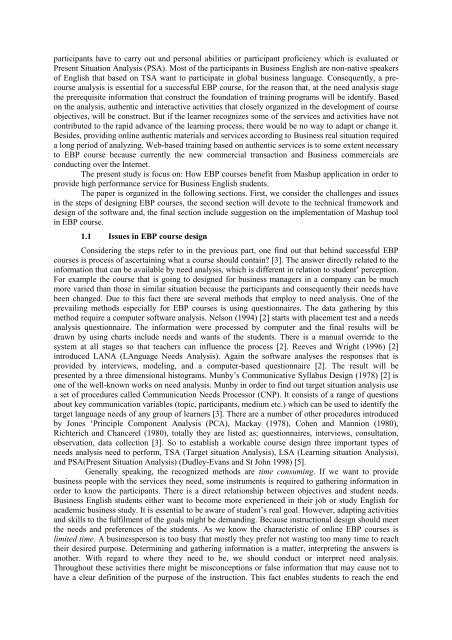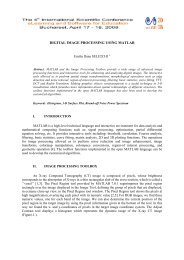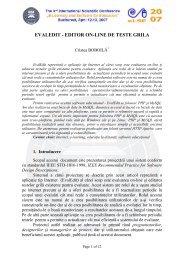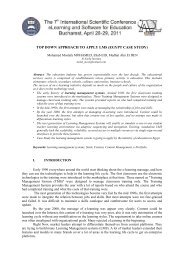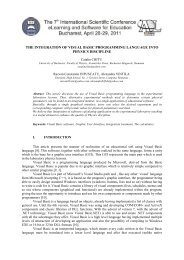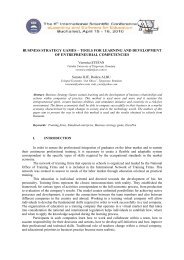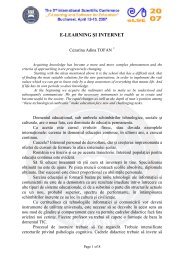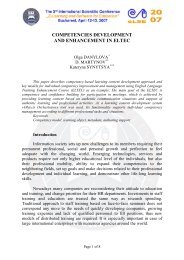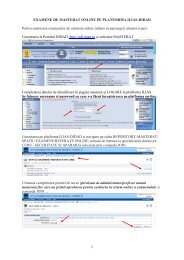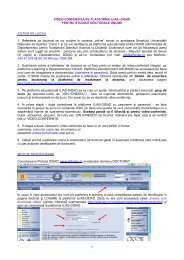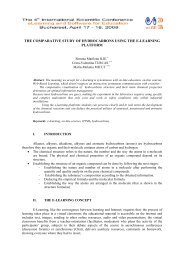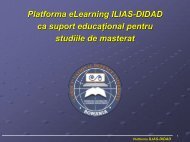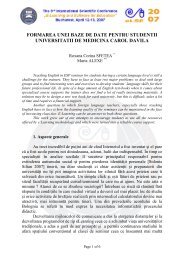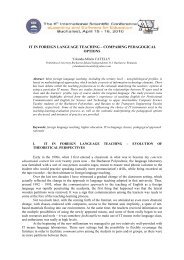designing a novel and high performance online english for business ...
designing a novel and high performance online english for business ...
designing a novel and high performance online english for business ...
Create successful ePaper yourself
Turn your PDF publications into a flip-book with our unique Google optimized e-Paper software.
participants have to carry out <strong>and</strong> personal abilities or participant proficiency which is evaluated orPresent Situation Analysis (PSA). Most of the participants in Business English are non-native speakersof English that based on TSA want to participate in global <strong>business</strong> language. Consequently, a precourseanalysis is essential <strong>for</strong> a successful EBP course, <strong>for</strong> the reason that, at the need analysis stagethe prerequisite in<strong>for</strong>mation that construct the foundation of training programs will be identify. Basedon the analysis, authentic <strong>and</strong> interactive activities that closely organized in the development of courseobjectives, will be construct. But if the learner recognizes some of the services <strong>and</strong> activities have notcontributed to the rapid advance of the learning process, there would be no way to adapt or change it.Besides, providing <strong>online</strong> authentic materials <strong>and</strong> services according to Business real situation requireda long period of analyzing. Web-based training based on authentic services is to some extent necessaryto EBP course because currently the new commercial transaction <strong>and</strong> Business commercials areconducting over the Internet.The present study is focus on: How EBP courses benefit from Mashup application in order toprovide <strong>high</strong> <strong>per<strong>for</strong>mance</strong> service <strong>for</strong> Business English students.The paper is organized in the following sections. First, we consider the challenges <strong>and</strong> issuesin the steps of <strong>designing</strong> EBP courses, the second section will devote to the technical framework <strong>and</strong>design of the software <strong>and</strong>, the final section include suggestion on the implementation of Mashup toolin EBP course.1.1 Issues in EBP course designConsidering the steps refer to in the previous part, one find out that behind successful EBPcourses is process of ascertaining what a course should contain? [3]. The answer directly related to thein<strong>for</strong>mation that can be available by need analysis, which is different in relation to student‟ perception.For example the course that is going to designed <strong>for</strong> <strong>business</strong> managers in a company can be muchmore varied than those in similar situation because the participants <strong>and</strong> consequently their needs havebeen changed. Due to this fact there are several methods that employ to need analysis. One of theprevailing methods especially <strong>for</strong> EBP courses is using questionnaires. The data gathering by thismethod require a computer software analysis. Nelson (1994) [2] starts with placement test <strong>and</strong> a needsanalysis questionnaire. The in<strong>for</strong>mation were processed by computer <strong>and</strong> the final results will bedrawn by using charts include needs <strong>and</strong> wants of the students. There is a manual override to thesystem at all stages so that teachers can influence the process [2]. Reeves <strong>and</strong> Wright (1996) [2]introduced LANA (LAnguage Needs Analysis). Again the software analyses the responses that isprovided by interviews, modeling, <strong>and</strong> a computer-based questionnaire [2]. The result will bepresented by a three dimensional histograms. Munby‟s Communicative Syllabus Design (1978) [2] isone of the well-known works on need analysis. Munby in order to find out target situation analysis usea set of procedures called Communication Needs Processor (CNP). It consists of a range of questionsabout key communication variables (topic, participants, medium etc.) which can be used to identify thetarget language needs of any group of learners [3]. There are a number of other procedures introducedby Jones „Principle Component Analysis (PCA), Mackay (1978), Cohen <strong>and</strong> Mannion (1980),Richterich <strong>and</strong> Chancerel (1980), totally they are listed as; questionnaires, interviews, consultation,observation, data collection [3]. So to establish a workable course design three important types ofneeds analysis need to per<strong>for</strong>m, TSA (Target situation Analysis), LSA (Learning situation Analysis),<strong>and</strong> PSA(Present Situation Analysis) (Dudley-Evans <strong>and</strong> St John 1998) [5].Generally speaking, the recognized methods are time consuming. If we want to provide<strong>business</strong> people with the services they need, some instruments is required to gathering in<strong>for</strong>mation inorder to know the participants. There is a direct relationship between objectives <strong>and</strong> student needs.Business English students either want to become more experienced in their job or study English <strong>for</strong>academic <strong>business</strong> study. It is essential to be aware of student‟s real goal. However, adapting activities<strong>and</strong> skills to the fulfilment of the goals might be dem<strong>and</strong>ing. Because instructional design should meetthe needs <strong>and</strong> preferences of the students. As we know the characteristic of <strong>online</strong> EBP courses islimited time. A <strong>business</strong>person is too busy that mostly they prefer not wasting too many time to reachtheir desired purpose. Determining <strong>and</strong> gathering in<strong>for</strong>mation is a matter, interpreting the answers isanother. With regard to where they need to be, we should conduct or interpret need analysis.Throughout these activities there might be misconceptions or false in<strong>for</strong>mation that may cause not tohave a clear definition of the purpose of the instruction. This fact enables students to reach the end


